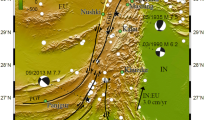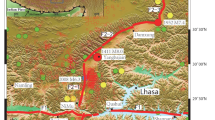Abstract
The authors firstly evaluate the strain accumulation rate of the Xianshuihe fault zone based on earthquake activity. We calculated the stress and seismic moment accumulation rate for each subsection of the Xianshuihe fault zone based on the distribution of geological slip rate and GPS survey results. According to the results, we get the recurrence intervals of characterized earthquakes on each subsection respectively. A three-dimensional finite element model for western Sichuan is constructed to discuss the earthquakes triggering among major earthquakes ({ntM}>6.7) that occurred along the Xianshuihe fault zone since 1893. The calculated Coulomb failure stress changes (ÄCFS) show that 5 of the 6 earthquakes with Ms>6.7 were triggered by positive ÄCFS. The interactions between major earthquakes not only influence recurrence intervals of characterized earthquakes on each subsection, but also change recurrence behavior of major earthquakes along the whole fault zone.
Similar content being viewed by others
References
Deng Q D, Zhang P Z, Ran Y K, et al. Basic characteristics of active tectonics of China. Sci China Ser D-Earth Sci, 2003, 46(4): 356–372
Zhang P Z, Deng Q D, Zhang G M, et al. Active tectonic blocks and strong earthquakes in continental of China. Sci China Ser D-Earth Sci, 2003, 46(Suppl): 13–24
The Earthquake Disaster Prevention Department of the State Seismological Bureau. Catalogue of Later-day Earthquake (in Chinese). Beijing: China Science and Technology Press, 1999
The Earthquake Disaster Prevention Department of the State Seismological Bureau. Catalogue of Chinese Historical Strong Earthquakes (in Chinese). Beijing: Seismological Press, 1995
Wen X Z. Quantitative Estimates of Seismic Potential on Active Faults (in Chinese). Beijing: Seismological Press, 1995
Zhou R J, He Y L, Huang Z Z, et al. The slip rate and strong earthquake recurrence interval on the Qianning-kangding segment of the Xianshuihe fault zone. Acta Seismol Sin (in Chinese), 2001, 23(3): 250–261
Yi G X, Fang J, Wen X Z. Study on faulting behavior and fault-segments for potential strong earthquake risk along the central-southern segment of Xianshuihe fault zone based on current seismicity. Earthquake (in Chinese), 2005, 2005, 25(1): 58–66
Yi G X, Wen X Z, Xu X W. Study on recurrence behaviors of strong earthquakes for several entireties of active fault zones in Sichuan-Yunnan region. Earthquake Res China (in Chinese), 2002, 18(3): 267–276
Zhang Q W, Zhang P Z, Wang C, et al. Earthquake triggering and delaying caused by fault interaction on Xianshuihe fault belt, southwestern China. Acta Seismol Sin (in Chinese), 2003, 25(2): 143–153
Papadimitriou E, Wen X Z, Karakostas V, et al. Earthquake triggering along the Xianshuihe fault zone of western Sichuan, China. Pure Appl Geophys, 2004, 161: 1683–1707
Okada Y. Internal deformation due to shear and tensile faults in a half-space. Bull Seismol Soc Amer, 1992, 82(2): 1018–1040
Zhao S, Muller R D, Takahashi Y, et al. 3-D finite-element modelling of deformation and stress associated with faulting: Effect of inhomogeneous crustal structures. Geophys J Int, 2004, 157(2): 629–644
Li P. Xianshuihe-Xiaojiang Fault Zone (in Chinese). Beijing: Seismological Press, 1993
Zhang G M, Ma H S, Wang H, et al. Boundaries between active-tectonic blocks and strong earthquakes in the China mainland. Chin J Geophysics (in Chinese), 2005, 48(3): 602–610
Zhu A L, Xu X W, Zhou Y S, et al. Relocation of small earthquakes in western Sichuan, China and its implications for active tectonics. Chin J Geophys (in Chinese), 2005, 48(3): 629–636
Wang C Y, Han W B, Wu J P, et al. Crustal structure beneath Songpan-Garze orogenic belt. Acta Seismol Sin (in Chinese), 2003, 25(3): 229–241
Wang C Y, Chan W W, Mooney W D. Three-dimensional velocity structure of crust and upper mantle in southwestern China and its tectonic implications. J Geophys Res, 2003, 108(B92442), doi: 10.1029/2002JB001973
Wen X Z. Character of rupture segmentation of the Xianshuihe-Anninghe-Zemuhe fault zone, western Sichuan. Seismol Geol (in Chinese), 2000, 22(3): 239–249
Ran H L, He H L. research on the magnitude and recurrenc interval of characterized earthquakes with magnitude ⩾6.7 along the northwestern portion of the Xianshuihe fault zone in western Sichuan. Chin J Geophys (in Chinese), 2006, 49(1): 153–161
Xu X W, Wen X Z, Zheng R Z, et al. Pattern of latest tectonic motion and its dynamics for active blocks in Sichuan-Yunnan region, China. Sci China Ser D-Earth Sci, 2003, 46(Suppl): 210–226
Wang, Q, Zhang P Z, Greymueller J T, et al. Present-day crustal deformation in China constrained by global positioning system measurements. Science, 2001, 294: 574–577
Wang M, Shen Z K, Niu Z J, et al. Contemporary crustal deformation of the Chinese continent and tectonic block model. Sci China Ser D-Earth Sci, 2003, 46(Suppl): 25–40
Niu Z J, Wang M, Sun H, et al. Contemporary velocity field of crustal movement of Chinesemainland from Global Positioning System measurements. Chin Sci Bull, 2005, 50(9): 939–941
Shen Z K, Wang M, Gan W J, et al. Contemporary tectonic strain rate field of Chinese continent and its geodynamic implications. Earth Sci Front (in Chinese), 2003, 10(Suppl): 83–100
Jiang Z S, Ma Z J, Zhang X, et al. Horizontal strain field and tectonic deformation of China mainland revealed by preliminary GPS results. Chin J Geophys (in Chinese), 2003, 46(3): 352–358
Yang S M, Wang Q, You X Z. Numerical analysis of contemporary horizontal tectonic deformation fields in China from GPS data. Acta Seismol Sin (in Chinese), 2005, 27(2): 128–138
Stein R S. The role of stress transfer in earthquake occurrence. Nature, 1999, 402: 605–609
Qiao X J, Wang Q, Du R L. Characteristics of current crustal deformation of active blocks in the Sichuan-Yunnan region. Chin J Geophys (in Chinese), 2004, 47(5): 805–811
Zhu S B, Cai Y E, Shi Y L. The contemporary tectonic strain rate field of continental china predicted from GPS measurements and its geodynamic implication. Pure Appl Geophys, 2006, 163: 1477–1493
Smith B, Sandwell D. Coulomb stress accumulation along the San Andreas Fault system. J Geophys Res, 2003, 108(B6), 2296, doi: 10.1029/2002JB2136
Liao C T, Zhang C S, Wu M L, et al. Stress change near the Kunlun fault before and after the Ms8.1 Kunlun earthquake. Geophys Res Lett, 2003, 30(20): 2027, doi:10.1029/2003GL018106
Zhang Y J, Peng L G, Cheng W Z. Study on source parameters of the Maerkang Earthquake sequence. Earthquake Res China (in Chinese), 2006, 22(1): 85–93
Qin J Z, Qian X D, Ye J Q. A study on the focal parameters of Shidian Ms= 5.9 earthquake sequences in 2001. Acta Seismol Sin (in Chinese), 2005, 27(3): 250–259
Wang H, Zhang G M, Wang S Y, et al. Stress and strain fields of active tectonic blocks in the China mainland deduced by seismological methods. Chin J Geophys (in Chinese), 2004, 47(6): 1035–1043
Stein R S, Barka A A, Dieterich J H. Progressive failure on the North Anatolian fault since 1939 by earthquake stress triggering. Geophys J Int, 1997, 128(3): 594–604
Freed A M. Earthquake triggering by static, dynamic, and postseismic stress transfer. Ann Rev Earth Planet Sci, 2005, 33: 335–367
Zhang H, Liu M, Shi Y L, et al. Toward an automated parallel computing environment for geosciences. Phys Earth Planet Int, 2007, 163: 2–22
Melosh H J, Raefsky A. A simple and efficient method for introducing faults into finite element computations. Bull Seismol Soc Amer, 1981, 71: 1391–1400
Cianetti S, Giunchi C, Cocco M. Three-dimensional finite element modeling of stress interaction: An application to Landers and Hector Mine fault systems. J Geophys Res, 2005, 110(B5S17), doi: 10.1029/2004JB003384
Teng J W, Zeng R S, Yan Y F, et al. Depth distribution of Moho and tectonic framework in eastern Asia continent and its adjacent ocean areas. Sci China Ser D-Earth Sci, 2003, 46(5): 428–446
Chen H R, Chen L W, Ma H S, et al. 3-D finite element modeling for evolution of stress field and interaction among strong earthquakes in Sichuan-Yunnan region. Acta Seismol Sin (in Chinese), 2004, 26(6): 567–575
Kagan Y Y, Jackson D D. Seismic gap hypothesis: Ten years after. J Geophys Res, 1991, 96(B13): 21419–21431
Liu M, Yang Y Q, Stein S, et al. Crustal shortening in the Andes: Why do GPS rates differ from geological rates? Geophys Res Lett, 2000, 27(18): 3005–3008
Author information
Authors and Affiliations
Corresponding author
Additional information
Supported by the Ministry of Science and Technology of China (Grant No. 2004CB418406), and the “Basic Science Research Plan” of the Institute of Earthquake Science, China Earthquake Administration (Grant No. 2007-03)
Rights and permissions
About this article
Cite this article
Wang, H., Liu, J., Shi, Y. et al. Dynamic simulation of interactions between major earthquakes on the Xianshuihe fault zone. Sci. China Ser. D-Earth Sci. 51, 1388–1400 (2008). https://doi.org/10.1007/s11430-008-0110-8
Received:
Accepted:
Published:
Issue Date:
DOI: https://doi.org/10.1007/s11430-008-0110-8




